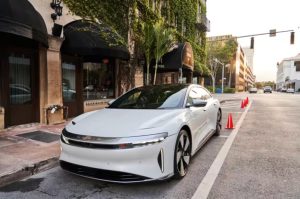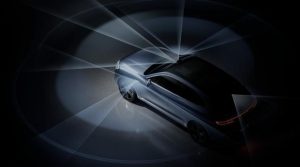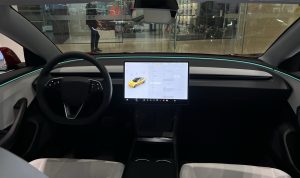Focus Analysis | Electric Cars Set Sail, EU Launches Anti-Subsidy Investigation
7 min read
The aftermath of the Munich Auto Show had barely dissipated when a bucket of cold water was poured on Chinese automakers.
On September 13th local time, European Commission President Ursula von der Leyen announced the initiation of an anti-subsidy investigation into Chinese electric vehicles. Von der Leyen believes that the global electric vehicle market is flooded with competitively priced Chinese cars, and their low prices are due to massive national subsidies, which are “distorting” the European market.
Simultaneously, European Commission Vice President and Trade Commissioner Valdis Dombrovskis stated on social media that the EU would investigate Chinese electric vehicles. He plans to visit China next week to discuss trade, economic opportunities, and challenges.
Regarding the EU’s announcement of an anti-subsidy investigation into electric vehicles, a spokesperson for the Chinese Ministry of Commerce explicitly stated, “China will closely monitor the EU’s protectionist tendencies and follow-up actions and firmly defend the legitimate rights and interests of Chinese companies.”
The EU has been contemplating targeted policies towards Chinese electric vehicles for some time. In June of this year, the French government began pushing for the EU to launch dual investigations (anti-dumping and anti-subsidy) into Chinese electric vehicle companies, and at that time, the EU had not yet provided a clear response.
Therefore, it was not surprising that the EU suddenly made a move against Chinese automakers just three days after the Munich Auto Show ended.
Amid the global wave of new energy vehicles, China’s automotive industry is rising at an unprecedented pace. According to data from the China Association of Automobile Manufacturers, in the first half of this year, China’s total automobile exports reached 2.341 million units, a year-on-year increase of 76.9%, surpassing Japan in the half-year automobile export volume for the first time and ranking first in the world.
From January to July this year, China exported 636,000 new energy vehicles, an increase of 150% compared to the same period last year. Europe is one of the main export markets for China’s new energy vehicles. According to Cui Dongshu, the Secretary-General of the China Passenger Car Association, Chinese cars account for 48% of China’s total exports of new energy vehicles to Europe.
A representative from an automaker also mentioned to 36Kr that when entering countries in Southeast Asia and the Middle East, it’s mainly about volume, and there is limited assistance in building the brand. “Only by exporting to Europe can we establish our brand image. That’s why we want to go to Europe.”
As a global automotive industry hub, Europe is a highland that automakers must conquer in the era of new energy vehicles. BYD has already launched five models in Europe, NIO has also introduced five new cars in Europe, and plans to complete the construction of 120 battery swap stations in Europe by the end of this year. XPeng also plans to launch the international versions of the P7 and G9 in the German market in 2024.
Industry insiders also believe that this year, especially for Chinese new energy vehicle companies entering Europe, is a critical year. “In the past few years, we have been exploring distribution systems in Europe, setting up stores, so our sales have not been good. We have just clarified our strategy this year and are starting to make efforts.”
However, under the pressure of the EU’s anti-subsidy investigation, can Chinese domestic brands smoothly expand into Europe?
Anti-subsidy Investigation and Its Impact
The core content of the EU’s anti-subsidy investigation is whether the Chinese government provides subsidies to Chinese automakers, to assess whether the EU should impose tariffs.
It is important to note that, although China’s national and local subsidies for the domestic market have been phased out, the scope of subsidies mentioned by the EU is very broad. An industry insider told 36Kr that even the purchase tax can be considered a subsidy, and free license plates can also be counted.
According to the EU Regulation on Foreign Subsidies Distorting the Internal Market, which was implemented in 2023, the European Commission has the authority to investigate foreign subsidy activities for up to ten years. For subsidies obtained before the implementation of the regulation, as long as the subsidy was obtained within five years before the regulation’s implementation and still has a distorting impact on the EU market after the regulation’s implementation, it can also be investigated.
This means that the EU’s anti-subsidy investigation into China can be traced back to 2018. Therefore, industry insiders believe that if the EU initiates an investigation, the conclusion and measures are essentially predetermined; “it’s just a matter of finding a basis, and a high probability of imposing tariffs.”
Currently, Chinese new energy vehicles exported to Europe are not low in price. For example, the 2023 BYD Dolphin has a price range of CNY 189,800 to 279,800 in the domestic market, while the two versions of the model sold in Europe are priced at EUR 44,900 and EUR 50,990, which is approximately CNY 352,400 and CNY 400,200 respectively, nearly double the price.
The BYD Dolphin and Tesla Model 3 in Europe are priced similarly, and if additional tariffs are imposed, it will again raise the prices of Chinese exported new energy vehicles, which is clearly unfavorable for Chinese automakers’ overseas sales in Europe.
However, the maximum investigation duration for anti-dumping and anti-subsidy investigations in the EU is 15 months and 13 months
, respectively. In other words, Chinese companies have a window of about one year to respond. Overall, the impact of the anti-subsidy investigation on Chinese automakers is not significant at present.
On the one hand, Chinese companies selling cars in Europe can be divided into two categories. Those with higher sales, such as SAIC Motor and Lynk & Co., have European brand backgrounds, are highly recognized in Europe, and can also produce locally, so they are minimally affected by the anti-subsidy investigation.
Apart from car companies with European backgrounds, BYD has the highest sales in Europe among independent brands, but it only sold 4,083 units in the whole of 2022, which is not yet at a scale.
On the other hand, in the long run, Chinese automakers going abroad are no longer limited to selling cars but are moving the entire industry chain and building car factories locally. BYD revealed at the Munich Auto Show that the location of its first European factory would be determined later this year. SAIC Group is also choosing a location in Europe and is preparing to build or acquire a complete vehicle factory.
Battery manufacturer CATL settled in Germany earlier, starting construction of its first overseas factory in Thuringia in 2019, which has already begun production earlier this year.
However, building factories in Europe is not an easy task; environmental requirements, labor costs, equipment standards, and other factors are challenges that Chinese companies need to overcome. If the EU’s anti-subsidy investigation is successful, it may also become an opportunity for Chinese companies to accelerate local production in Europe for better compliance.
Subsidies Are Common in Europe and the U.S.
The formulation of policies related to the automotive industry by countries has always been cautious. When Japan, which has global brands such as Toyota and Honda, announced in 2035 that it would ban the sale of gasoline-powered cars, then-Toyota CEO Akio Toyoda publicly stated that if Japan rushed to ban gasoline cars, it would result in the loss of millions of jobs. A hasty transformation could cut Japan’s industrial main artery.
Toyoda’s comments were not alarmist; the automotive industry can be a pillar industry in any country. It represents a country’s industrial level, bringing together science and technology with advanced productivity. For example, in Germany, the largest economy in Europe, the automotive industry accounts for about 5% of the country’s economic output. Companies like Volkswagen and BMW alone provide more than 800,000 jobs.
Therefore, during the transition from gasoline cars to new energy cars, countries with strong traditional automotive industries are sparing no effort to support their domestic new energy vehicle industries. This is true for China, Europe, and the United States.
Since 2020, more than 20 European Union countries have successively introduced subsidy policies for electric vehicles. France and Germany offer a maximum government subsidy of €6,000 for pure electric vehicles. France’s subsidy was discontinued on January 1, 2023, while Germany’s government still offers a maximum subsidy of €4,500.
The impact of subsidy policies on the electric vehicle industry is particularly significant in the United States. Earlier this year, the Inflation Reduction Act (IRA) officially took effect. Automakers can receive a tax credit of $7,500, but there are two conditions.
First, electric vehicles must be assembled in North America, with a maximum price limit of $55,000. Second, a corresponding proportion of raw materials in the vehicle’s battery must be extracted or processed in the United States or in countries with free trade agreements with the United States. If only one of these requirements is met, the tax credit is reduced to $3,750.
After the IRA came into effect, U.S. automakers thrived, while numerous foreign brands, including Volkswagen, Hyundai, Nissan, and BMW, were unable to obtain the subsidy. Chinese automakers, led by BYD, even temporarily abandoned their plans to enter the U.S. market.
Previously, countries had been using subsidy policies to support the automotive industry. However, China’s subsidy policy has now exited the stage of history. According to the notice on the promotion and application of fiscal subsidies for new energy vehicles in 2022 issued by four departments including the Ministry of Finance, the new energy vehicle purchase subsidy policy ended on December 31, 2022.
In a recent disassembly and cost analysis of the BYD Dolphin by UBS Securities, the overall cost of the Dolphin is 15% lower than that of competing models in the same class, and the cost of a similar model produced in Europe by Volkswagen is 35% higher.
Jato Dynamics data shows that in the first half of 2022, the average cost of Chinese electric vehicles in Europe was less than €32,000, while the average cost in Europe was about €56,000.
As manufacturing costs for electric vehicles continue to decline, the center of gravity of the global automotive industry is shifting to China. The EU’s anti-subsidy investigation, in an effort to maintain its market position, was already expected.
However, as the quantity of Chinese automakers exporting to Europe has not yet reached a significant scale, the anti-subsidy investigation could either become a hammer to strike the Chinese electric vehicle industry or an opportunity for Chinese companies to accelerate overseas production in Europe for better compliance and higher sales; it remains uncertain.



